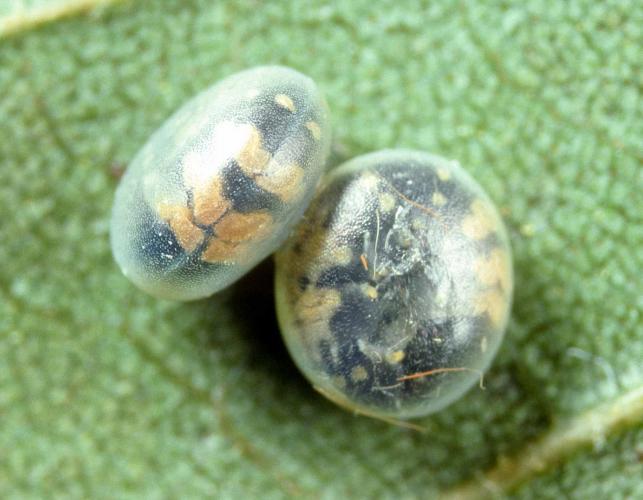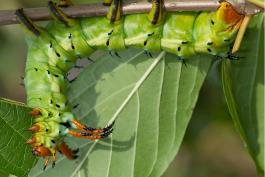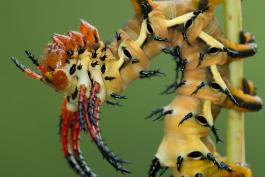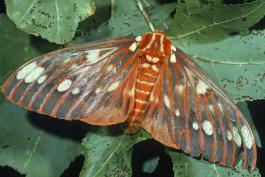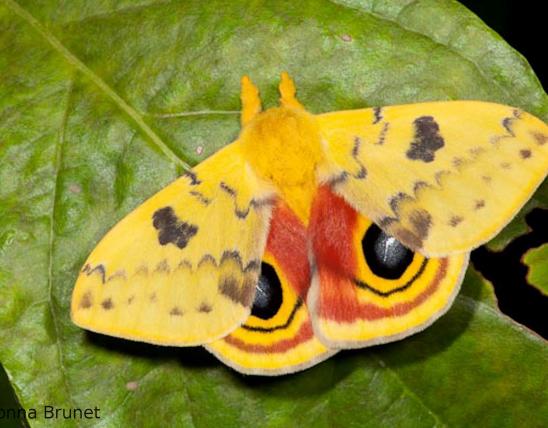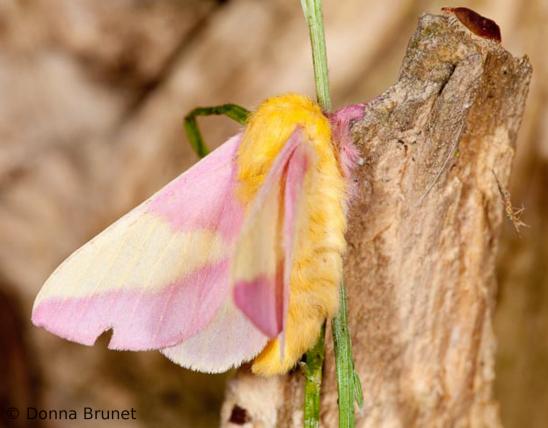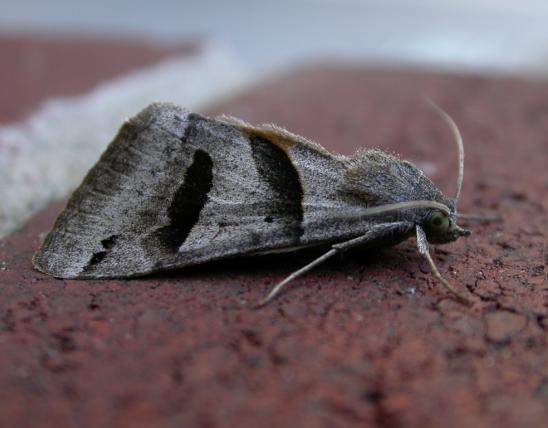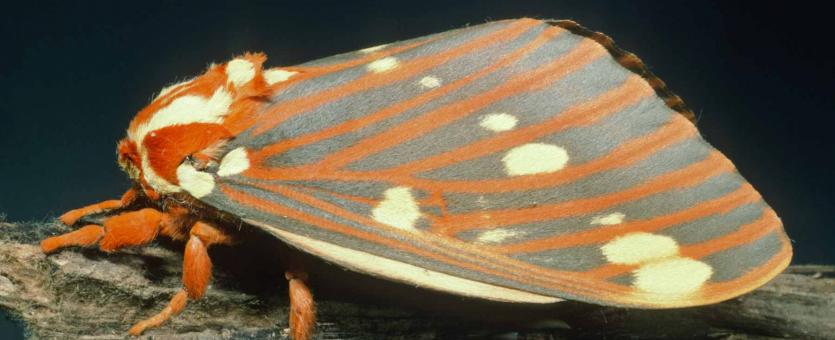
Adult regal moths are enormous. The forewings are overall gray, tan, or slightly olive, with orange or reddish-orange veins and pale yellow spots. Hindwings are more orange, usually with a yellow patch at the base. The body appears furry and is orange with pale yellow markings.
Adult males have the same pattern and color as females but are smaller, with narrower wings. As with other giant silkworm moths, the males’ antennae are large and feathery — they are used to detect the scents emitted by females.
The spectacular caterpillar of this species is famous enough to have its own name: hickory horned devil. When mature, they can be up to 5½ inches long. There’s really no mistaking them. The color is highly variable but is usually green with blue, black, white, yellow, and reddish or orange markings, and long, curved horns on the back behind the head that are orange with bluish-black tips. Rows of smaller spines run down the rest of the body. Younger stages are spinier, with branching spines along the body, and look quite different, with the smallest hatchlings mostly black, and middle stages orangish or reddish.
To learn more about giant silkworm and royal moths as a group, visit their family page.
Wingspan: 4–6 inches. Caterpillar length: to 5½ inches.
Statewide. Well-established in the Ozarks and eastern Missouri; also scattered in other regions of the state.
Habitat and Conservation
Regal moths, like most other moths, are most common in places where their food plants are numerous. In the case of this species, their habitat is deciduous woodlands with plenty of black walnuts, hickories, sumacs, persimmon, sycamores, and so on. This explains why they are most common in the Ozarks and eastern Missouri — the parts of our state that are more extensively wooded.
Most of the time, people only see the adults when they are attracted to lights at night; they typically fly between 9:30 p.m. and midnight.
Food
Like most other members of the giant silkworm moth family, the adult moths of this species have reduced mouthparts and do not eat.
The caterpillars, however, feed on the foliage of many species of trees and shrubs. Hickories (Carya), including pecan, and their close relatives, black walnut and butternut, top the list. The caterpillars are called hickory horned devils for that reason. Sweet gum, sycamore, ashes, lilac, and cotton are also eaten.
In Missouri, the favorite larval foods are black walnut, butternut, various species of sumac (Rhus), and persimmon.
Status
Breeding resident.
Although the caterpillars are huge and look ferocious, they are harmless.
Life Cycle
There appears to be a single generation in our state, with records from May through August, usually peaking in the hot, humid weather of mid-July and early August. As winged adults, they probably live for only one or two weeks, so mating and egg-laying must occur quickly. They usually mate the first evening after the night they emerge from pupation. Like most other giant silkworm moths, females attract males by releasing pheromones (scents). The males are highly sensitive to these scents and fly upwind, following the scent until they find the female. The pheromones are usually only released for a short period at a specific time of day or night. In regal moths, the calling time is from about 9:30 p.m. to midnight.
Starting the night after mating, females deposit up to 3 eggs at a time on the leaves of suitable host plants. After about a week, the caterpillars hatch out of their eggs and start to eat. They live individually, not in groups. Early-stage caterpillars are camouflaged to look like bird droppings, and they rest on the tops of leaves. The defense of older caterpillars is to look huge and scary! After about 35 days as caterpillars, they’re large enough to move down from the tree canopies to pupate underground.
When mature, the caterpillars burrow into the soil to pupate in the ground. Most people see these breathtaking larvae as they are creeping around, looking for a place to dig into the soil. The caterpillars are usually seen between July and October. They overwinter as pupae.
Human Connections
The hot-dog-sized, spiky caterpillars certainly make an impression. What do you think about nature when it shakes you up, shows you something that does not fit your expectations?
The genus name, Citheronia, refers to the Cithaeron (or Kithairon) mountains in Greece; these mountains figure into several famous stories from Greek mythology. Entomologists in the 1700s and 1800s often drew on names from Greek and Roman literature when naming butterflies and moths.
Ecosystem Connections
Occasionally, a pupating hickory horned devil may stay underground an extra year, emerging an entire year after the rest of its generation. Apparently, this can be an insurance policy in species that pack such an important part of their life cycle into just a few weeks. If some catastrophe occurs and wipes out the adult moths (or their eggs or larvae) one summer, at least a few caterpillars can miss the devastation and survive to mate the following year.
As they grow older and larger, the caterpillars of this species have big appetites, as they stoke up nutrition enough to last through the winter (and maybe even another year), emerge from pupation, and spend a very busy last week or two as a winged adult.





